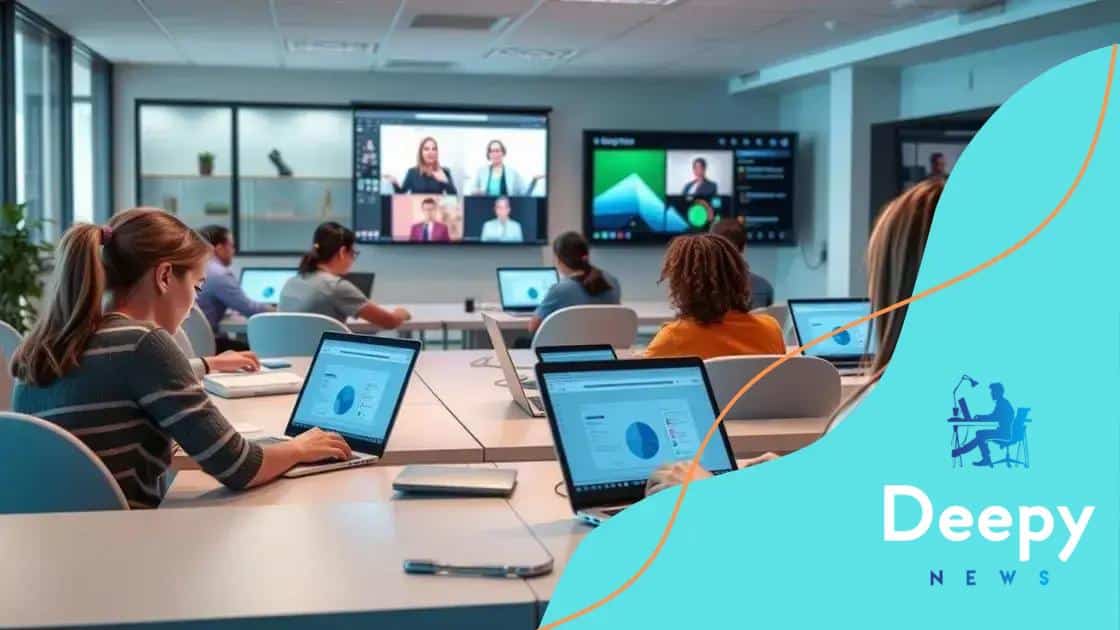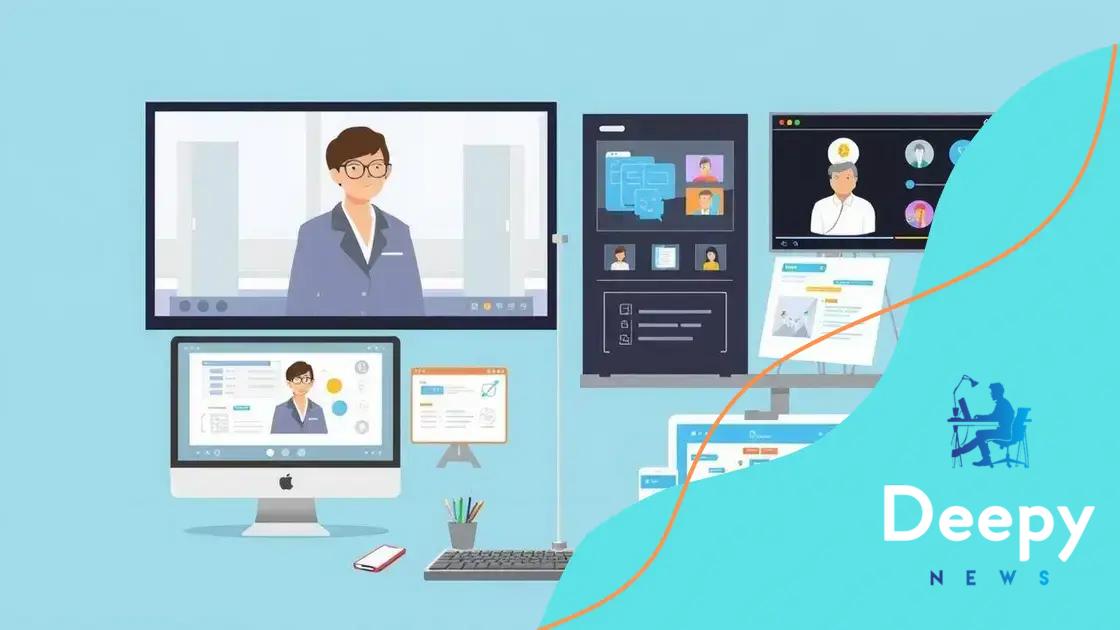Virtual classrooms: the future of higher education

Virtual classrooms are evolving the future of higher education by offering flexible, accessible learning experiences while leveraging technology to enhance engagement and personalization in education.
In today’s world, virtual classrooms are becoming a cornerstone of higher education. They offer flexibility and innovative ways of learning, but how do they truly impact students and institutions? Let’s dive deeper.
Understanding virtual classrooms
Understanding virtual classrooms is essential in today’s digital age. These innovative spaces allow students from different locations to engage in learning without being physically present in a traditional classroom. As technology evolves, so do the methods of delivering education.
What Are Virtual Classrooms?
In simple terms, a virtual classroom is an online environment where learners can attend classes via the internet. This setup can include live video lectures, interactive discussions, and collaborative projects. The flexibility of learning anywhere at any time is one of the significant advantages.
Benefits of Virtual Classrooms
Let’s explore why these digital classrooms are gaining popularity:
- Accessibility: Students can join from anywhere in the world.
- Cost-effectiveness: It reduces commuting and accommodation costs.
- Wide range of resources: Learners can access various materials online.
- Flexibility: Class schedules can be more accommodating to different lifestyles.
Moreover, with virtual classrooms, instructors can integrate multimedia elements such as videos, quizzes, and interactive tools that enhance the learning experience. This approach caters to various learning styles, making education more inclusive.
As these platforms gain traction, they also introduce new challenges. Issues like maintaining student engagement and ensuring reliable internet access can affect the effectiveness of these classrooms. However, instructors and institutions are continually developing strategies to address these concerns.
In conclusion, virtual classrooms represent a shift towards a more flexible and accessible education model. By incorporating innovative technology, they aim to enhance learning experiences for students around the globe.
Benefits of virtual learning
The benefits of virtual learning are numerous and have reshaped the way education is delivered today. Students can learn from anywhere, enabling them to combine studies with other commitments. This flexibility is especially appealing to those who have jobs or family responsibilities.
Enhanced Accessibility
One of the most significant advantages of virtual learning is how it increases accessibility. Students can connect to classes from various locations. Whether they are in a different city or country, virtual platforms make it easy to attend lectures.
Cost Savings
Another important benefit is cost savings. Virtual learning often reduces expenses related to commuting and housing. Students can save money that would typically be spent on transportation or accommodation near a campus. This financial relief can make education more attainable.
- No commuting costs.
- Reduced need for housing costs.
- Lower expenses for books and materials due to online resources.
Additionally, virtual classrooms often utilize diverse learning materials, such as videos and interactive discussions. This variety can lead to a more engaging educational experience. Students can revisit recorded lectures whenever they need a refresher, making it easier to grasp complex subjects.
Furthermore, the use of technology in virtual learning environments can help develop crucial digital skills. These skills are essential in today’s job market. Being familiar with online tools and platforms gives students an advantage in their future careers.
While there are many benefits, it’s also worth noting that some students may struggle with self-discipline and motivation in a virtual setting. Institutions are aware of this and provide valuable resources to help people stay engaged.
Technology driving virtual classrooms

The technology driving virtual classrooms plays a crucial role in shaping modern education. Innovations in digital tools enhance the learning experience and facilitate effective communication between students and teachers. These technologies allow for seamless interaction in ways that traditional classrooms may not.
Video Conferencing Tools
One of the primary technologies used in virtual classrooms is video conferencing. Platforms like Zoom, Microsoft Teams, and Google Meet enable real-time discussions, presentations, and group activities. This technology serves as the backbone for live virtual lectures, making it possible for students to engage with instructors and peers.
Learning Management Systems (LMS)
Another significant development is the use of Learning Management Systems. These platforms, such as Canvas, Moodle, and Blackboard, allow educators to organize course content, track student progress, and facilitate assignments. This centralization helps keep everything organized and accessible for both teachers and students.
- Course materials are easily available.
- Assignments can be submitted online.
- Feedback can be provided in real-time.
In addition to these tools, collaboration applications like Google Workspace and Microsoft 365 provide extensive features that aid in teamwork. Students can work together on projects, share documents, and brainstorm ideas from different locations. By combining these tools, students can mimic the collaborative spirit of a physical classroom in a virtual setting.
Moreover, the integration of interactive content, like quizzes and gamified learning experiences, keeps students engaged. Adaptive learning technologies can also customize learning experiences based on a student’s unique needs and progress. This personalization enhances the educational journey by ensuring that learners can work at their own pace.
As technology continues to evolve, virtual classrooms are becoming even more sophisticated. The inclusion of virtual reality (VR) and augmented reality (AR) might lead to immersive learning experiences, offering students a chance to engage in simulations that bring lessons to life.
Challenges of online education
The challenges of online education are important to consider as learning shifts to digital platforms. While virtual classrooms provide numerous benefits, they also present unique obstacles that can affect student success and engagement.
Maintaining Student Engagement
One of the main difficulties is maintaining student engagement in a virtual setting. Without the physical presence of a teacher and classmates, some students may feel isolated or less motivated to participate. To combat this, educators often use interactive tools and group activities.
Technical Issues
Technical problems can also pose challenges for online learners. Issues such as poor internet connectivity, software glitches, or unfamiliarity with technology can disrupt the learning process. Students may miss important information due to these technical difficulties.
- Slow internet can lead to interrupted classes.
- Unfamiliar software may frustrate users.
- Technical assistance may not be readily available.
Additionally, the lack of hands-on experiences in some subjects can hinder learning. Certain fields, like science and engineering, benefit greatly from practical activities. Virtual simulations can help, but they may not fully replace experiential learning.
Another significant challenge is the lack of personal interaction. Social connections play a critical role in education, and students may miss out on the spontaneous discussions and relationship-building opportunities that come from being in a physical classroom.
Instructors and institutions are aware of these challenges and are working to improve online education. Some are implementing more support systems, such as mentoring programs or peer collaborations, to facilitate better learning experiences.
Future trends in higher education
The future trends in higher education are increasingly shaped by advances in technology and changing student needs. As the landscape of learning continues to evolve, several key trends are emerging that promise to transform how education is delivered and experienced.
Increased Online Learning
The shift towards online learning is one of the most significant trends. More institutions are offering programs entirely online, making education more accessible to a wider audience. This trend is expected to continue as technology improves and more students seek flexible learning options.
Personalized Learning Experiences
Another promising development is the move towards personalized learning experiences. With data-driven insights, educators can tailor courses to meet the individual needs and learning styles of students. This approach helps ensure that each student can progress at their own pace.
- Customized course materials based on student performance.
- Adaptive learning technologies that respond to learner needs.
- Focus on strengths and weaknesses to aid understanding.
Moreover, there is a growing emphasis on skills-based learning. Institutions are increasingly aligning their curricula with the demands of the job market. Students are being prepared not just to earn degrees but also to acquire practical skills that employers value. This shift bridges the gap between education and employment.
Collaboration between educational institutions and industries is expected to rise. This collaboration may lead to internship opportunities and practical training experiences that enhance students’ job readiness. Partnerships with businesses will help create relevant programs that reflect current workforce needs.
Lastly, the integration of artificial intelligence (AI) into education systems holds great potential. AI can assist in automating administrative tasks, providing smart tutoring systems, and analyzing student performance to enhance outcomes.
In conclusion, the world of higher education is rapidly changing due to advancements in technology and evolving student needs. Virtual classrooms offer flexibility and accessibility, while the incorporation of personalized learning and skills development prepares students for future careers. However, challenges like maintaining engagement and addressing technical issues must be tackled to fully realize these benefits. As we look forward, embracing these trends will help create a more inclusive and effective educational environment for all learners.
FAQ – Frequently Asked Questions about Virtual Classrooms
What are virtual classrooms?
Virtual classrooms are online environments where students can participate in courses, interact with teachers, and engage with peers from anywhere in the world.
What are the benefits of online learning?
Online learning offers flexibility, accessibility, and cost savings, allowing students to learn at their own pace and from various locations.
What challenges do students face in online education?
Students may struggle with maintaining engagement, dealing with technical issues, and missing out on personal interactions found in traditional classrooms.
How is technology shaping future trends in higher education?
Technology is driving trends like increased online learning, personalized educational experiences, and the integration of AI to enhance learning outcomes.






